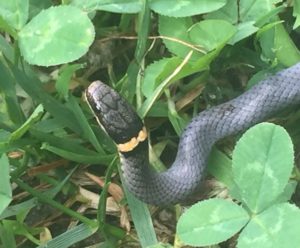Vol. 14 Issue 3, Fall 2009
By Emily Cook
Can a snake be considered “cute” or even beautiful?

Photo by Sharon Plummer
Some people may not think so, but there is a little gem known as the Northern Ringneck Snake (Diadophis punctatus edwardsii) that might cause even the most snake-fearing individuals to reconsider.
These sleek, petite members of the reptile family only grow to about 10-15 inches at maturity. Their color can vary from olive to gray but is usually a deep bluish-black that carries a glossy sheen.
The Ringneck gets its name from the slender band of yellow or red that usually encircles its neck like a necklace or “ring” just below the snake’s large, flat head. The ring color carries through on the snake’s underbelly, running the length of its body.
Quite prevalent in the Northern Virginia area, this variety of snake is particularly common in those areas closest to the Shenandoah Mountain range. Preferring moist wooded areas in hardwood or pine forests, the Northern Ringneck will nest in a limitless variety of substrates including rotten logs, leaf litter, or even a backyard sawdust pile.
Since they are highly social, they prefer to curl up together in hiding, and multiple females will often lay their egg clusters in one common nest. Breeding takes place during the spring, with up to ten eggs laid in June or July. The snake’s lifespan can be up to 20 years.
As effective at defense as it is at offense, the Ringneck is surprisingly mighty and brave. It will hold its own if threatened and has an arsenal of defense mechanisms at its disposal. Initially, the snake will try to threaten an attacker by coiling its tail, exposing the colorful underside. If that fails to thwart off the offender, it will release a foul-smelling odor and finally resort to biting to get its point across.
Not to worry though. Your chances of encountering a Northern Ringneck are pretty slim. Not only are they nocturnal, they are reclusive and rarely seen out in the open. However, should you come across one of these attractive little beauties, have no fear. Even though they pack a powerful bite for their prey, they rarely break the skin on humans.
Despite the Northern Ringneck’s slender and unimposing size, this little snake is quite a good hunter. As a result, they are very beneficial, in that they help control many rodent species and other pests such as voles, carpenter ants, and copperheads that might otherwise become a nuisance.
Primary Source:
Virginia Department of Game and Inland Fisheries: Northern Ringneck Snake, https://www.dgif.virginia.gov/wildlife/information/northern-ring-necked-snake/

